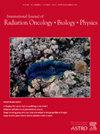探究接受质子放射治疗的儿科患者的放射诱发莫亚莫亚综合征与放射剂量之间的关系:质子射线治疗后儿科患者的莫亚莫亚综合征。
IF 6.4
1区 医学
Q1 ONCOLOGY
International Journal of Radiation Oncology Biology Physics
Pub Date : 2024-11-15
DOI:10.1016/j.ijrobp.2024.11.070
引用次数: 0
摘要
目的:接受质子放疗(PRT)的小儿脑肿瘤患者中,辐射诱发莫亚-莫亚综合征(RIMMS)的发病率和相关风险因素仍然鲜为人知。本研究的目的是确定中枢神经系统质子放疗(PRT)在儿童队列中的 RIMMS 发生率,并评估其与威利斯环(COW)或视丘(OC)剂量的关系:我们对接受颅内 PRT 治疗的小儿脑肿瘤患者(1995-2021 年)进行了回顾性研究。我们关注的是视交叉的平均剂量,因为视交叉非常靠近COW血管。Wilcoxon 秩和检验用于确定 OC 剂量与 RIMMS 之间的关系。使用单变量逻辑回归模型确定以 52Gy 为切点的 RIMMS 发生几率:结果:在 676 名患者中,14 人罹患 RIMMS,中位发病时间为 1.9 年。8年后RIMMS的累积发病率为2.4%。RIMMS患者的平均OC剂量高于非RIMMS患者(51.5 Gy vs 23.7 Gy, p 52 Gy与剂量小于52 Gy的患者相比,RIMMS风险更高(OR = 9.9, p结论:在我们以质子治疗为主的儿科队列中,RIMMS 的发生率仍然很低,8 年间的累积发生率为 2.4%,与光子治疗队列相似。RIMMS的发生与COW和OC的剂量较高有关。本文章由计算机程序翻译,如有差异,请以英文原文为准。
Exploring the Relationship Between Radiation-Induced Moyamoya Syndrome and Radiation Dose for Pediatric Patients Treated With Proton Radiation Therapy
Purpose
The incidence and risk factors associated with radiation-induced moyamoya syndrome (RIMMS) in pediatric brain tumor patients treated with proton radiation therapy (PRT) remain poorly understood. The objective of this study was to determine the incidence of RIMMS in the setting of central nervous system PRT in a pediatric cohort and assess its relationship with dose to the circle of Willis (COW) or optic chiasm (OC).
Methods and Materials
We performed a retrospective review of pediatric brain tumor patients treated with intracranial PRT (1995-2021). The exposure of interest was mean dose to the OC due to close proximity to the COW vasculature. Wilcoxon rank-sum test was used to determine the association between OC dose and RIMMS. Univariable logistic regression modeling was used to determine the odds of developing RIMMS based on a cut point of 52 Gy.
Results
Of 676 patients, 14 developed RIMMS, with a median onset of 1.9 years. The cumulative incidence of RIMMS at 8 years was 2.4%. Patients with RIMMS had a higher mean OC dose than those without (51.5 vs 23.7 Gy, P < .0001). Univariable logistic regression showed that patients with an OC dose > 52 Gy had increased RIMMS risk compared with those with a dose < 52 Gy (odds ratio = 9.9, P < .001).
Conclusions
The incidence of RIMMS remains low in our primarily proton-treated pediatric cohort with a cumulative incidence of 2.4% over 8 years and is similar to that of photon-treated cohorts. Development of RIMMS was associated with higher doses to the COW and OC.
求助全文
通过发布文献求助,成功后即可免费获取论文全文。
去求助
来源期刊
CiteScore
11.00
自引率
7.10%
发文量
2538
审稿时长
6.6 weeks
期刊介绍:
International Journal of Radiation Oncology • Biology • Physics (IJROBP), known in the field as the Red Journal, publishes original laboratory and clinical investigations related to radiation oncology, radiation biology, medical physics, and both education and health policy as it relates to the field.
This journal has a particular interest in original contributions of the following types: prospective clinical trials, outcomes research, and large database interrogation. In addition, it seeks reports of high-impact innovations in single or combined modality treatment, tumor sensitization, normal tissue protection (including both precision avoidance and pharmacologic means), brachytherapy, particle irradiation, and cancer imaging. Technical advances related to dosimetry and conformal radiation treatment planning are of interest, as are basic science studies investigating tumor physiology and the molecular biology underlying cancer and normal tissue radiation response.

 求助内容:
求助内容: 应助结果提醒方式:
应助结果提醒方式:


